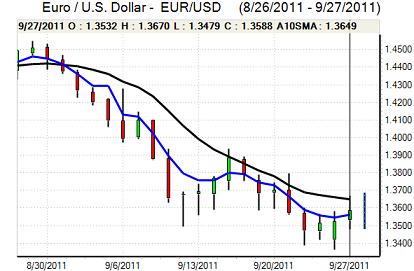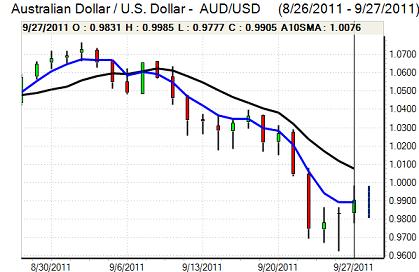EUR/USD
The Euro found support in the 1.35 region against the dollar on Tuesday and rallied to a high just above 1.3650 during the New York session. There was a heavy bout of short-covering in a further correction from over-sold conditions both in the Euro and equity markets.
There were increased hopes that the Euro-zone banks would be able to provide additional support through the EFSF fund which would lessen the debt-default crisis. In particular, there was a strong rally in European financial share prices as panic surrounding the banking sector eased. Steady German consumer confidence and firmer money-supply growth provided some Euro support.
There were still a high degree of unease over the situation as Greek parliamentary approval of the property tax did little to bolster underlying confidence. There were doubts surrounding ratification of increased powers for the EFSF and there was evidence of substantial friction over any further extensions of the fund, especially in the ‘hard Euro’ countries. Thursday’s German parliamentary vote on the EFSF was inevitably an important focus for these concerns. There were further doubts whether a majority of Chancellor Merkel’s coalition would back the measure which would leave the government dependent on opposition support. The German Finance Ministry also stated strong opposition to any further expansion of the fund. In this environment, fear could return extremely quickly
The US consumer confidence index was little changed at 45.4 for September from 45.2 previously and remained trapped near historic lows while house prices fell 4.1% in the year to July according to the Case-Shiller index.
Dollar demand was still dominated by defensive considerations rather than the US fundamental outlook, although there was unease surrounding the debt outlook. The Euro retreated back to the 1.3550 area in Asia on Thursday as underlying fears persisted and position adjustment eased.

Source: VantagePoint Intermarket Analysis Software
Call now and you will be provided with FREE recent forecasts
that are up to 86% accurate * 800-732-5407
If you would rather have the recent forecasts sent to you, please go here
Yen
The dollar found support in the 76.30 area against the yen during Tuesday and rallied to a high in the 76.90 area before correcting back to 76.50. An improvement in risk appetite triggered a reduction in defensive yen demand and the rally in financial stocks was particularly important in curbing yen demand as the Euro attempted to pull away from 10-year lows.
The yen was still broadly resilient to selling pressure as underlying caution prevailed. There were also further reports of quarter-end capital repatriation which underpinned the currency.
Markets will still be on high alert over the possibility of intervention as there will be strong pressure for Bank of Japan action if there is any evidence of renewed economic deterioration.
Sterling
Sterling maintained a strong tone during Tuesday and, after finding support in the 1.5525 region against the dollar, there were strong gains to a peak near 1.57 while the UK currency held gains against the Euro.
The economic data did not have a significant impact with the CBI retail survey weakening to -15 in September from -14 the previous month. Bank of England MPC member Miles stated that he was close to voting for additional quantitative easing in September, echoing remarks made by Broadbent the previous day.
Sterling gained support from a strong recovery in banking stocks and there were increased hopes that the UK would effectively get a free ride from any Euro-zone rescue attempts. Any increased support for the European banking sector would also tend to improve the UK banking-sector outlook.
Sterling retreated back towards 1.5620 in Asia on Wednesday as the dollar staged a wider recovery.
Swiss franc
The dollar was put on the defensive against the franc on Tuesday as there was a wider improvement in risk appetite and it dipped to lows just below 0.8950 before recovering back to near 0.90 in Asia on Wednesday. The Euro struggled for traction on the crosses, again dipping to below the 1.22 level.
The UBS consumption index fell to 0.79 in September from 1.28 the previous month and this was the lowest reading since the fourth quarter of 2009. Evidence of a sharp slowdown in the economy will increase pressure on the National Bank to both curb any renewed gains and also to engineer a further weakening in the currency.

Source: VantagePoint Intermarket Analysis Software
Call now and you will be provided with FREE recent forecasts
that are up to 86% accurate * 800-732-5407
If you would rather have the recent forecasts sent to you, please go here
Australian dollar
The Australian dollar continued to rally strongly during Tuesday as it corrected over-sold conditions and also gained support from a strong rally in risk appetite. The Australian currency moved to a high around 0.9980 against the US currency, but was unable to move back above parity and dipped back to the 0.9850 area in Asia on Wednesday.
There will still be a lack of confidence in the global economy which will make it difficult for the Australian currency to secure strong buying support. Domestically, there was a small rebound in house sales for August, but the underlying trend remained weak.



